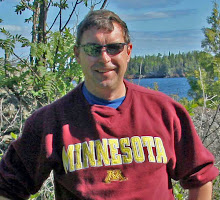.jpg)
The last couple of weeks have been absolutely beautiful in central Indiana. The maples are brilliant yellow and orange, the burning bush is a bright red, the corn is gold and ready for harvest. I was driving east to work one morning last week under a canopy of tall maples. As I came to a clearing the sun was just beginning to rise, the wispy clouds in the sky caught the reds, oranges and white of the upcoming day. The gold leaves on the trees glowed. I felt like pulling over to the side of the road and just watching the spectacle. By the time I got to work 15 minutes later the sun was higher on the horizon and the fireworks in the sky were gone. As I glance out my window today, many of the trees that were so stunning last week are now bare. Time flies, moments pass saved to memory only or at least until next fall.
I was in an exercise class last weekend. The instructor had just moved here from Israel. He had never seen a Midwestern Fall. There was one tree that was bare along with a number that were in full color. He made the comment, “do they all get like that (the bare one), that’s depressing.” I was thinking yes they all lose their leaves. That’s why we need to appreciate them now while they are in full color. We may need to go a bit slower to take in the full effect. It will be different tomorrow.
How many times have you wished things were like the way they were yesterday, or a year ago? How much time are you spending worrying about what may be in the future? You can't change the past or control the future. The only thing we can control is what is happening right now. How much time have you set aside to enjoy the “now?”
I took a few minutes last week, sat in my back yard and just watched the leaves fall off the trees. I heard sounds I hadn’t heard before; I watched birds and animals I did not know were there. I was in the “now" and if felt refreshing.
I was in an exercise class last weekend. The instructor had just moved here from Israel. He had never seen a Midwestern Fall. There was one tree that was bare along with a number that were in full color. He made the comment, “do they all get like that (the bare one), that’s depressing.” I was thinking yes they all lose their leaves. That’s why we need to appreciate them now while they are in full color. We may need to go a bit slower to take in the full effect. It will be different tomorrow.
How many times have you wished things were like the way they were yesterday, or a year ago? How much time are you spending worrying about what may be in the future? You can't change the past or control the future. The only thing we can control is what is happening right now. How much time have you set aside to enjoy the “now?”
I took a few minutes last week, sat in my back yard and just watched the leaves fall off the trees. I heard sounds I hadn’t heard before; I watched birds and animals I did not know were there. I was in the “now" and if felt refreshing.
A priest recommended to me a long time ago to "listen to the whispers". The only way you can hear a whisper is to slow down and take the time to listen and observe.
Take some time and celebrate the “now” this week. You’ll be glad you did.
Until next time – all the best!
RolandB
Take some time and celebrate the “now” this week. You’ll be glad you did.
Until next time – all the best!
RolandB


.jpg)
